Part Two: Oct. 15, 2006
Through The Minefield
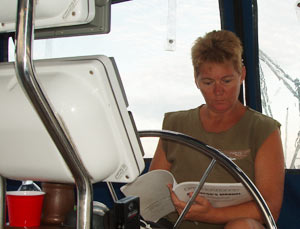 Sonja studies the chartplotter manual while the autopilot keeps the boat on course.
Sonja studies the chartplotter manual while the autopilot keeps the boat on course.
After a late (8am) start, we headed up to Seahorse Reef before making our turn toward the panhandle. There was some disagreement between the two GPSs as to exactly where Seahorse Reef was located; it was discovered to be operator error on the new Furuno plotter. Glad I brought my ancient Garmin GPS 12 and a paper navigation chart! Those fancy things are nice, but it's harder to get confused with raw data from a primitive unit.
I took the first shift on the helm, and it was a real struggle to find 38 by 11 feet of Gulf that was not occupied by crab traps, most of which seemed to have about 20 feet of line floating across the surface. This in 20 feet of water. Oh, and some clever crabbers thought BLUE is an appropriate color to paint the floats. Others chose black. Only one had the brains to paint the things bright pink.
We zigzagged through the crab trap minefield at 5 knots or so for an hour, at which point Sonja took over. She's a good multi-tasker, but programming the new chartplotter while maintaining course while missing the omnipresent trap lines proved to be a bit much for her. Once the plotter was correctly informed of our destination, she settled in and did a fine job of dodging through the various traps. Note for future reference: they put these traps out on the 15th of October, which would be a good day to END any future trips.
Onward Like a Herd of Turtles
There was good sailing wind for most of the day; the wind was behind us, but not too far behind us. By staying ten degrees above our desired course, we were able to keep the speed above 5 knots, frequently above 6 knots. It's great to feel a big, fat cruiser blast along at 6.5.
Toward the end of the day, we came across the only vessel traffic of the day: a power cruiser 70 feet or more in length, doing at least 18 knots, on an intercept course. Though we had right of way, I told Sonja to deviate a bit to allow him to pass, on the assumption that the boat might well be piloted by a drunken moron who was not paying attention. It was going to be a fairly close pass.
At the same time, I was making an effort to shake out the reefs in the mainsail, but the single line reefing was once again making life difficult. My plan was to try a little wing on wing sailing, as the wind had subsided a bit, and we were having trouble sustaining 5 knots. When I was ready, I asked for another course deviation, this one taking us back into the path of the fast-approaching cruiser.
As soon as we turned, the powerboat did as well, probably thinking we were a bunch of drunken morons who were paying no attention to traffic as we messed with our sails. I guess he was paying attention after all, but you always have to wonder if someone crossing the Gulf like that has just set the autopilot and gotten distracted by something else.
My estimation of our ability to carry sails wing on wing on our desired course was a bit off. OK, so somehow it was 45 degrees off. Can't get a mainsail to jibe when you want it to, but the darn thing sure needed a preventer a few minutes before. I tried everything I could think of, but in the diminishing winds, we were down to 3.3 knots on average.
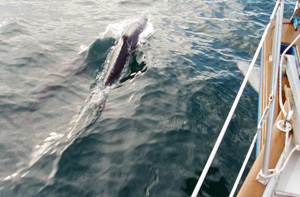 Dolphins, dolphins everywhere
Dolphins, dolphins everywhere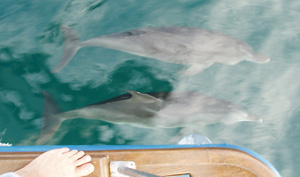
There were at least 4 dozen dolphins swimming and surfacing all around the boat.
The fancy new GPS chartplotter said our time enroute had climbed from 18 hours to 26 or so, which number was not well received by the crew. On came the iron genny, which was needed to run the engine-driven refrigeration anyway. Soon we were steaming along on course again at a little over 5 knots. Some bored dolphins showed up to play in our bow wave, and I got up on the pulpit to shoot a few pictures.
Sailing, then Motorsailing, then Sailing, then Motorsailing
We motorsailed for a while, then the wind picked back up a bit and we shut the engine down, always a blessed moment aboard a sailboat. Well, almost always, but let's not skip ahead just yet.
In the evening, we were making only a few knots, and fired up the engine to assist. It was spitting cooling water, but less than usual. The strainer was clean, but we could see it was sucking some bubbles. Apparently, something had latched onto the grate outside the through hull fitting, partially restricting the flow. It was dark enough that I wasn't interested in another swim, so we proceeded with about half engine power, plus sails, making 4 to 5 knots.
Dolphins Escort Us and Entertain Us
Around this time, our three dolphin escorts were joined by many more, 4 dozen dolphins at least. They were everywhere around the boat, and seemed to be enjoying the big dolphin bow wave party. At one point, we stopped and tried some high speed reversing, to see if it would clear whatever was obstructing the engine. The dolphins scattered in all directions, and seemed quite confused by our antics, but happy to come back and play around the boat when we resumed course.
I took the 8 to 10 watch on the helm that night, planning to sleep from 10 to 2, then get back up for another two hours on the wheel and two more keeping Sonja company. The best laid plans...
Furling The Jib — Or, Attempting To Furl the Jib
About ten minutes after I went to bed, Sonja and I heard the jib flapping and the furler turning. What were they doing up there? Well, trying to furl the jib, obviously, and by the sounds, it was not going well. In a moment, I heard my name being called. I jumped up and went topside to find that the wind had increased quite a bit. Good thing we put a double reef in the main before dark. I figured it would not be needed, but also figured I didn't want to mess with it in the dark if it was needed. (My figuring was born of bitter experience.)
With the jib put away, we were cruising downwind at around 4-5 knots under double-reefed main and engine, and I went back to try to sleep. Sonja gave up on sleeping, and stayed up. We were rockin' and rollin' pretty good, but that never stopped me from sleeping before. The cabin door that didn't want to close was another matter. It kept popping open. I kept getting up to shut it, hoping it would stay shut and insulate me from the engine noise and cockpit conversation. It didn't want to do that. I tried propping it closed with some stuff that was lying around, but the stuff just got tossed aside as we rolled.
I read for a while, then my eyes got heavy and I tried sleeping some more. It was almost happening for me, when a drip of water from the window overhead landed right on my face. OK, I had a towel, I could deal with a little drip, but it was annoying, and further delayed sleep. I kept looking at my watch. Midnight. I could still catch a couple of hours, almost, but I was getting tossed around quite a bit, and that darn door kept coming open.
At around 12:45 or 1 am, I heard the engine's overheat alarm sound. It kept sounding. I heard voices, but the engine kept running. I got up with a sigh. No sleep tonight, I guess.
An Overcast Night. High Seas. No Moon. No Stars. No Compass Light!
Jon has damaged hearing, and could not hear that alarm at all, much to our astonishment. I went on up and shut the engine down. The wind was up high enough now that we were making close to 5 knots downwind just under our double-reefed main. Seas were getting pretty large.
It was then that I noticed we had no compass light! Open Gulf, heavy seas, building wind, an ominous weather forecast for things to get much worse before they get better, no moon and just enough cloud cover to obscure stars. No real way to steer the boat, in other words. Good thing the autopilot was up to the job!
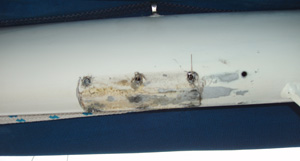 After a couple of hard jibes, the rigid boom vang was ripped out of the boom. Above you can see the mount on the underside of the boom where the vang is supposed to be. We sailed downwind the rest of the night trying very hard not to jibe again.
After a couple of hard jibes, the rigid boom vang was ripped out of the boom. Above you can see the mount on the underside of the boom where the vang is supposed to be. We sailed downwind the rest of the night trying very hard not to jibe again.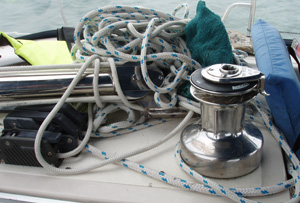
When I came topsides, the loose vang was lying in a pile of other loose stuff on the coach roof next to the companionway.
The Boom Vang Goes Boom
By the time I got up, they had already inadvertently jibed the boat a couple of times, and had somehow ripped the rigid boom vang out of the boom, so it was lying in the companionway. Stuff had been flying around all night, so the cabin looked like a tornado had blown through, and the cockpit wasn't much better. The wind and waves kept building; by now I could hear the occasional 6 foot sea white-capping above my right shoulder. I hate it when I'm in a tall cockpit of a large cruiser, and I can hear the white caps above me.
The whole time-span from about 2 am until dawn is kind of a blur. I remember picking an angle that I thought the autopilot could hold in these seas, pulling the main off the spreaders just a bit, and watching with amazement as our speed on the GPS frequently topped 6 knots. This boat really shouldn't go that fast on a deep downwind heading under double-reefed main alone, but it was.
We couldn't steer to our intended destination, but we happened to be pointing right at Dog Island. That seemed like a good refuge to us. It is an East-West strip of land, and the wind was forecast to come out of the south at up to 35 knots, with seas on the Gulf building to 10 to 12 feet. Small craft (meaning, in this case, below about 700 feet) were to exercise caution. We were exercising caution by averaging 5.5 knots toward Dog Island, with a projected arrival time of about 7:30 am.
The AutoPilot Gets Tired, the Humans Get Tireder
The autopilot was starting to scare me. It couldn't hold course very well any more, so I decided to hand-steer the boat. With no compass light, and just a bomb-range tower out in the Gulf as my guide, I wasn't doing a great job (OK, two jibes. Wham! Wham!), but I was exhausting myself. Sonja took over, did an excellent job for a beginner at this kind of thing, but also exhausted herself. Once we passed the bomb-tower, a little rain shower obscured the few radio towers which had been coming into view on shore, and I decided the autopilot was less scary than a helmsman with no visual cues and no compass, and put it back in control.
Around 6, I was lying on a cockpit bench, death grip on a piece of the jib furling line to keep myself in place, and shivering with cold, and I fell asleep. Clearly, I was too tired to be of any use whatsoever, so I went below and took a little nap, leaving Jon and Sonja to watch for traffic.
They woke me up within an hour, to help with the approach into the anchorage, such as it is, at Dog Island. It was getting light, and though the conditions were still pretty bad, it didn't seem as bad in the light. We had to sail around an area of shallow water, then turn to parallel the beach very close to shore. You might recall from yesterday's adventures that the engine had been overheating. I did not know the condition of the engine, and did not want to fire it up too early, only to have to shut it down, so we sailed straight up to a few boatlengths from the beach, where large breakers were crashing ashore, then turned to a beam reach along the shore.
I was not sure whether the boat would sail on that angle with just the double-reefed main, but it did just fine. The breakers just downwind made me very nervous, but it was reassuring to look at the chartplotter showing our course line parallel to the shore and the distance from shore remaining constant.
Finally, We Drop Anchor
We came around behind Dog Island and dropped a hook. Sonja had gotten no sleep at all, and went immediately to bed. Jon and I hung out a bit, watching to see that the anchor was holding and cleaning up a bit of the chaos, then I also went to bed. I awoke at 3:30 pm. I felt like going right back to sleep, but knew I would totally mess up my sleep cycle if I did that, so I got up and rummaged around for some food. It was good to be in a calm place. The wind was still quite strong, and not expected to get any better the next day. As the rest of the crew continued sleeping, I got a snack and a hot shower, which felt really great.
We had a relaxing afternoon, took Nicki to shore for a walk, cleaned up the boat and the people, chatted over cocktails, then had dinner. Even after sleeping most of the day, I went to bed at 10 that night. The winds were gusting above 20 all night. Up in the V-berth I woke up a few times and I could feel the boat swinging around on the anchor and heeling a bit just from the force of the wind on the mast and rig.
The sharp tug at the end of each swing told me the anchor was firmly planted, and I drifted right back off to sleep. I didn't get up until 7 am, which is very late for me, especially if I am on a boat.
Leave a Reply
You must be logged in to post a comment.